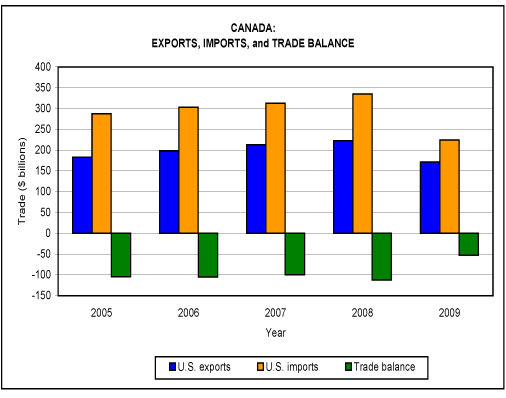View Section in Publication:: Return to Overview

Key Economic Trends
- The U.S. trade deficit with Canada, the largest U.S. trading partner, decreased by 53 percent to $52.9 billion in 2009, as the decline in imports was much larger than the drop in exports. The decline in the deficit for energy products represented 80 percent of the overall reduction in the deficit.
- In 2009, U.S. exports to Canada fell by $50.7 billion (23 percent) to $171.7 billion. The $20 billion decrease in exports of transportation equipment accounted for approximately 20 percent of the total export decline as U.S. auto manufacturers experienced steep declines in their Canadian sales. The value of U.S. exports of energy-related products also decreased significantly, falling by $6.6 billion (40 percent) primarily because of lower prices for crude petroleum, petroleum pro ducts, and natural gas.
- U.S. imports from Canada declined by 33 percent to $224.6 billion in 2009. The decrease in imports of energy-related products and transportation equipment together accounted for 62 percent of the total import decline. U.S. imports of energy-related products from Canada, the single largest U.S. supplier of energy-related products to the United States, declined both in price and volume.
Trade Shifts from 2008 to 2009
- U.S. trade deficit: Decreased by $59.5 billion (53 percent) to $52.9 billion
- U.S. exports: Increased by $9.3 billion (4 percent) to $222.4 billion
- U.S. imports: Decreased by $110.3 billion (33 percent) to $224.6 billion
Other Resources
- Canadian Department of Foreign Affairs and International Trade
- U.S. Central Intelligence Agency: World Factbook - Canada
- U.S. Department of Energy, Energy Information Administration: Country Analysis Brief - Canada
- U.S. Department of State: Background Note - Canada
